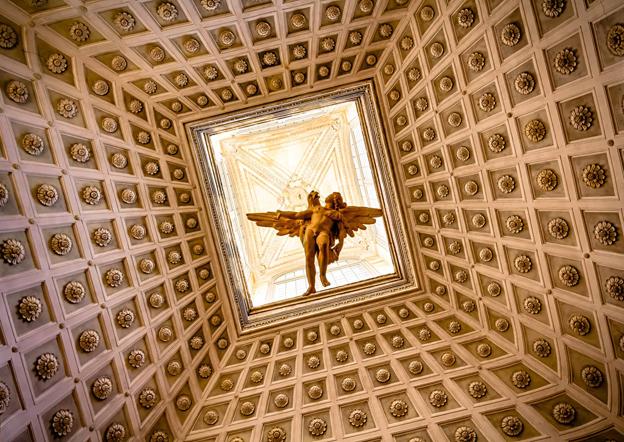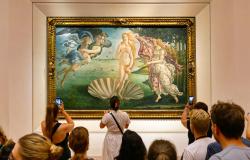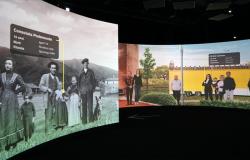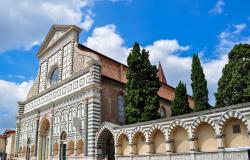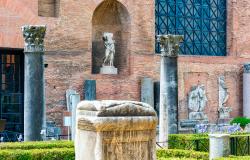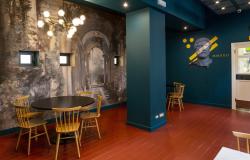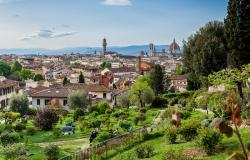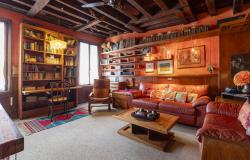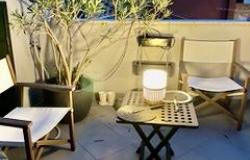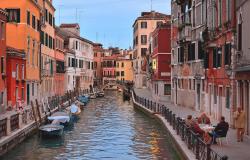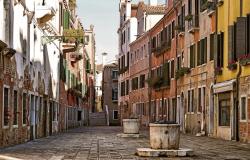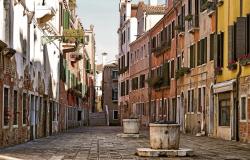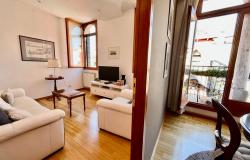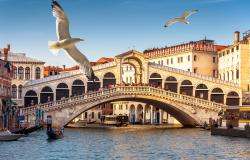[The Rape of Ganymede sculpture hanging in the Tribuna room inside Palazzo Grimani. Photo Credit: Jeff Hirsch.]
Too often, tourists in Venice limit their visits to St. Mark’s Square and the Rialto Bridge. But beyond those world-famous landmarks, Venice guards many little-known jewels that are sure to delight visitors willing to go off the beaten track.
Such is the case with the Palazzo Grimani. I recently discovered this stunning palazzo thanks to Best Venice Guides, an association of professional Venetian guides who is working to save it from the risk of closing down – for lack of visitors.
This would be a shame because Palazzo Grimani represents a unique aspect of the history and architecture of Renaissance Venice; and a visit to its impressive interiors will provide an extraordinary insight into the Venice of the 16th century, when the lagoon city sought to rival ancient Rome in the beauty and grandeur of its palaces and monuments.

[Palazzo Grimani, exterior. Photo credit: Silvia Donati.]
Originally the residence of the Venetian doge Antonio Grimani, the palace was redesigned and enlarged between 1532 and 1569 by his heirs: grandsons Vettore, procuratore generale of the city, and Giovanni, bishop and Patriarch of Aquileia, who gave the building its classical imprint. Giovanni in particular directed the works: a remarkable intellectual and scholar, he was a passionate collector of antiquities, just like his uncle Domenico.
Giovanni’s plan was to recreate the ancient Roman residence, which is clear as soon as you step into the courtyard, designed according to a style inspired both by the ancient Roman domus and the cultural climate of the Renaissance. The niches were created to display the Grimani’s collection of classical statues, which were also on view in the rooms of the piano nobile, where the large collection of antiquities, described as one of the most important in Venice by contemporary visitors, was matched by just as impressive colorful frescoes, elegant stuccoes, Roman-style gildings and Grotesque decorations, the latter inspired by images found inside the Domus Aurea.
To give the palace its classical imprint, Grimani never used Venetian artists for the palace’s design and decorations, but rather employed artists who had been trained in Rome and central Italy, among them Giovanni da Udine, Francesco and Giuseppe Salviati, Camillo Mantovano and Federico Zuccari. The result is an unprecedented combination of Tuscan-Roman elements within a Venetian environment.

[Decoration inside Palazzo Grimani. Photo credit: Palazzo Grimani Museum.]
Palazzo Grimani once housed as many as 200 pieces collected by Domenico and Giovanni Grimani. Approximately 130 pieces were displayed in the palace’s most admired room, the Tribuna, a space like no other in Venice, a high ceiling room inspired by Rome’s Pantheon, where the only source of light came from the top; today, like in the past, this room was the highlight of a visit to the palace, carefully studied to be reached only after going through a series of other rooms, to provide a sort of climax. In the Tribuna, the marvelous sculpture depicting the Rape of Ganymede, hanging in the center of the room, is a Roman replica of a late Greek model and was placed back in its original position after the palace’s restoration was completed.
Other impressive rooms include the Sala di Psiche, whose ceiling is decorated with paintings illustrating the myth of Love and Psyche, the work of Francesco Salviati; the Camerino di Callisto for its stucco decorations by Giovanni da Udine, who had studied them on ancient ruins in Rome, where he had worked with Raphael; and the Sala del Doge, dedicated to Antonio Grimani, where the walls are decorated with marble, as was typical in the classical world.
Most pieces from the Grimani’s collection are now housed inside the National Archeological Museum, which is why it makes a difference to visit Palazzo Grimani accompanied by a guide who will be able to show you what is no longer there through many captivating tales. The National Archeological Museum began its life in 1523 thanks to the donations made by Cardinal Domenico Grimani and is located on St. Mark’s Square.
When you visit Palazzo Grimani, you will not only spend a few pleasant hours discovering a remarkable Renaissance building; you will also help save a precious piece of Venetian history.

[Piano nobile, Palazzo Grimani.]
What you need to know to plan your visit of Palazzo Grimani
Palazzo Grimani is in the Castello district, near Campo Santa Maria Formosa, only a few minutes from St. Mark’s Square.
The tour of Palazzo Grimani is preceded by a visit to the Church of San Francesco della Vigna, whose façade was designed by Palladio according to ancient classical buildings, breaking with the previous style of Venetian buildings. The church houses the burial chapel of Giovanni Grimani and is the perfect introduction to the history of the palace and the Grimani family within the context of the Renaissance.
Best Venice Guides offers three free guided visits of Palazzo Grimani in the next few months, followed by a concert of ancient music. Entrance to the museum is €5 (for €10, you also get entry to Ca’ D’Oro, another Venice must-see).
Dates of next guided visits to Palazzo Grimani:
March 16, 3 pm
April 20, 3 pm
May 18, 3 pm
Reservations are mandatory and can be made by writing to prenotazione@bestveniceguides.it.
For more information, click here.
